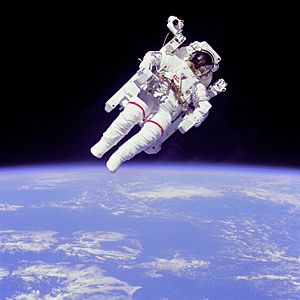Charles E. Whitsett facts for kids
Quick facts for kids
Charles E. Whitsett
|
|
|---|---|

Whitsett's vision becomes reality as Bruce McCandless II flys the manned maneuvering unit (MMU) on STS-41B in February 1984
|
|
| Born |
Charles Edward Whitsett Jr
October 18, 1936 |
| Died | October 14, 1993 (aged 56) |
| Nationality | American |
| Alma mater | Auburn University |
| Occupation | Engineer |
| Employer | NASA USAF |
| Known for | astronaut maneuvering unit (MMU) |
| Spouse(s) | Evelyn |
| Children | Edith, Steven, and Benjamin |
| Awards | Collier Trophy 1984 NASA Exceptional Engineering Achievement Medal 1986 |
Charles Edward "Ed" Whitsett Jr. (1936-1993) was an engineer for the United States Air Force (USAF) and NASA. He was an expert in helping astronauts move easily in space. His most important work was creating the astronaut maneuvering unit (MMU). This special backpack allowed astronauts to fly freely in space. It helped them rescue and fix satellites.
For this amazing invention, Whitsett and others received the 1984 Robert J. Collier Trophy. This award is for the "greatest achievement in aeronautics or astronautics in America."
Contents
About Ed Whitsett
Charles Edward "Ed" Whitsett Jr. was born on October 18, 1936, in Mobile, Alabama. He graduated from Auburn University in 1957.
Flying in Space
In 1961, Ed Whitsett started thinking about how astronauts could "fly" in space. This was even before any American astronaut had walked in space. He worked at the Air Force Institute of Technology (AFIT) in Ohio.
In 1962, he studied how the human body moves in zero gravity. He created math models to understand how people would move. He even used a special plane that flies in a way that creates weightlessness to test his ideas.
Whitsett began working at NASA in 1966. In 1968, astronaut Bruce McCandless joined Whitsett's team. They worked on what they called a "Buck Rogers style backpack." Whitsett also worked on the Apollo missions and Skylab. During the Apollo missions, astronauts spent many hours outside their spacecraft. Whitsett helped develop tools for them to move on the Moon. One tool was a hand-held "propulsion gun."
The MMU Backpack
In 1971, Whitsett designed a device powered by nitrogen gas, called the M509. He worked at NASA's Johnson Space Center (JSC). By 1973, Major Whitsett led the M509 experiment. He helped bring together research from both the Air Force and NASA.
Whitsett explained that the experimental MMU tested on the Skylab space station helped create the MMU used on the Space Shuttle. Dr. Charles E. Whitsett, Jr. and Astronaut McCandless were key people in the Skylab M509 experiment in 1973-74.
The M509 experiment showed how well the astronaut maneuvering unit (AMU) could fly. This helped with future AMU designs. The system included two jet-powered AMUs. It also had an automatically stabilized maneuvering unit (ASMU) and a handheld maneuvering unit (HHMU).
The ASMU used a high-pressure nitrogen tank for fuel. It had 14 thrusters (small jets) on the backpack. Astronauts controlled the thrusters with controls on arms that came from the backpack. Three astronauts flew these units inside Skylab. They tested how to operate them and reported their progress to Mission Control. When flying the AMU, the right hand controlled turning. The left hand controlled moving forward, backward, left, and right. A special computer helped the astronaut stay in place without using their hands.
After leaving the Air Force in 1977, Whitsett was hired by NASA. He spent over 100 hours practicing with the MMU simulator.
Collier Trophy Award
In February 1984, during the STS-41B Space Shuttle mission, astronaut Bruce McCandless made history. On his first space flight, he used the manned maneuvering unit (MMU) for a spacewalk. This was the first time an astronaut flew freely in space without being tied to the spacecraft.
McCandless used the MMU to help rescue three satellites. This included the Solar Maximum Mission satellite. Charles E. "Ed" Whitsett of the Johnson Space Center helped develop the MMU with astronaut McCandless.
In 1984, NASA and Martin Marietta Corporation received the Collier Trophy for creating the MMU. Charles E. Whitsett Jr. from NASA, Walter W Bollendonk from Martin Marietta, and astronaut McCandless were specifically honored.
Helping Build the Space Station
In 1990, Whitsett worked with astronauts on the STS-37 Shuttle mission. They tested an experiment called the Crew and Equipment Translation Aid (CETA). This experiment helped design systems for astronauts to move around outside the International Space Station (ISS).
Whitsett imagined many ways the MMU could be used on the ISS. These included helping to build the station, moving things around, inspecting the station, and even for rescue missions.

